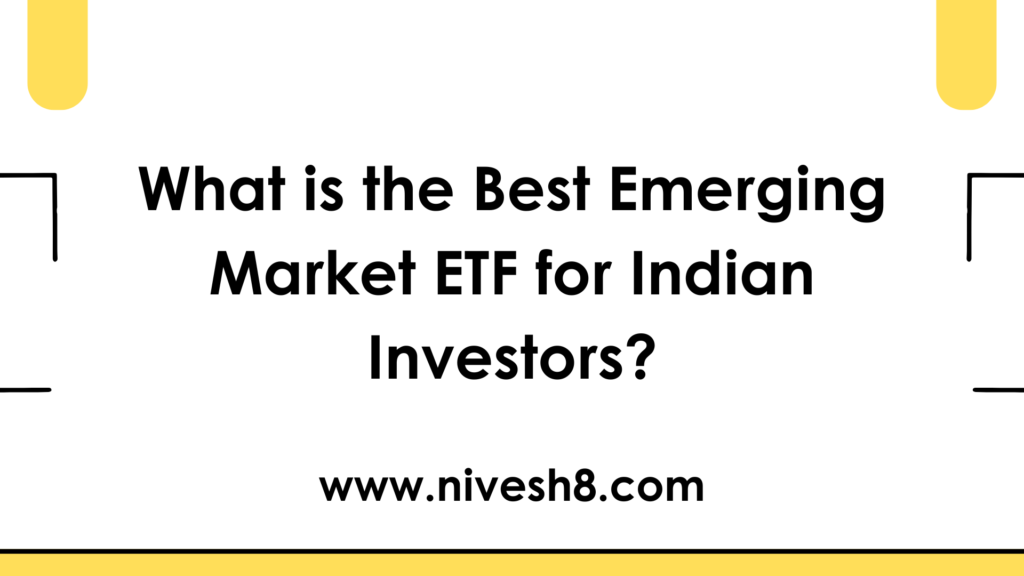The best emerging market ETF may be exactly what you need if you want exposure to fast-growing economies like India, China, Brazil, or South-east Asia yet wish to invest outside of Indian boundaries. These ETFs provide a clever approach to diversify your portfolio internationally while still concentrating on markets with great future growth capacity. Let’s dissect what emerging market ETFs are, how they operate, and which choices Indian investors should give thought to.
Describe an Emerging Market ETF
An emerging market ETF is a type of exchange-traded fund based on stocks of companies from underdeveloped nations. Though not as developed as the US or the UK, these nations are fast developing with middle-class populations rising, great infrastructure development, and expanding businesses. Usually, emerging markets comprise India, China, Brazil, Korea (South), Taiwan, Southern Africa, Indonesia, and Mexico.
An ETF following these markets exposes one to the top companies in these markets—including Alibaba, TSMC, Reliance, Samsung, and more.
Why should one invest in an ETF for emerging markets?
Many Indian investors seeking the best emerging market ETF have these reasons:
- Diversification: Globally distribute your investments to lower risk.
- High growth potential: These countries are supposed to surpass developed ones in speed.
- Access to international names: Many well-known worldwide brands originate from developing countries.
- ETFs pay less than actively managed worldwide mutual funds.
- Hedge against home risks: Should Indian markets collapse, other developing markets could shine.
- ETFs simplify things: You simply buy one unit and are then invested in many companies all around.
Top Emerging Market ETFs Worldwide (available through LRS Route)
The most well-known and often used ETFs Indian investors look at are these:
- iShares MSCI Emerging Markets ETF (EEM)
- Track MSCI Emerging Markets Index.
- Contains more than 1,000 stocks from 20+ nations.
- Among the first and biggest newly developed market ETFs.
- Provides wide exposure with reasonable liquidity.
- Track MSCI Emerging Markets Index.
- Vanguard FTSE Emerging Markets ETF (VWO)
- Lower expense ratio than EEM.
- Lays more of an emphasis on Asia.
- Includes businesses from Brazil, China, Taiwan, India.
- Excellent for low-cost long-term investors.
- Lower expense ratio than EEM.
- Schwab Emerging Markets Equity ETF (SCHE)
- Low expense ratio.
- Varied holdings exposed to mid-sized and large corporations.
- Good choice for investors on a budget.
- Low expense ratio.
US exchanges host these ETF listings. Under the Liberalised Remittance Scheme (LRS), where RBI let Indian citizens invest up to $250,000 overseas annually, you can invest in them.
Exist Indian alternatives for ETFs from emerging markets?
India currently lists few direct emerging market ETFs. Some Indian mutual funds, meanwhile, provide fund of funds investing in worldwide emerging market ETFs. Among such examples are:
- Mirae Asset NYSE FANG+ ETF FoF (for US tech only; not emerging)
- Edelweiss MSCI Emerging Markets Fund of Fund
- Motilal Oswal Nasdaq 100 FOF (not emerging but worldwide influence)
You probably have to invest through foreign brokers under the LRS path if you wish pure exposure to emerging markets.
Things to Think About Before Making an Investment
- Risk involving currency: Should INR strengthen, your returns in rupees could decline.
- Geopolitical risks: A few newly developing nations have political unrest.
- Volatility: Compared to developed markets, these ones can be more erratic.
- Fees: See the ETF’s brokerage expenses and expense ratio.
- Taxes: Gains from overseas ETFs are treated as debt funds in India.
Last Consideration
Your objective, risk tolerance, and investment strategy will all affect the best emerging market ETF. Emerging market ETFs are a smart, reasonably priced solution if you want to diversify your portfolio worldwide and bet on fast-growing economies. Start small, know the product, and make sure it makes sense for your whole investing strategy.



